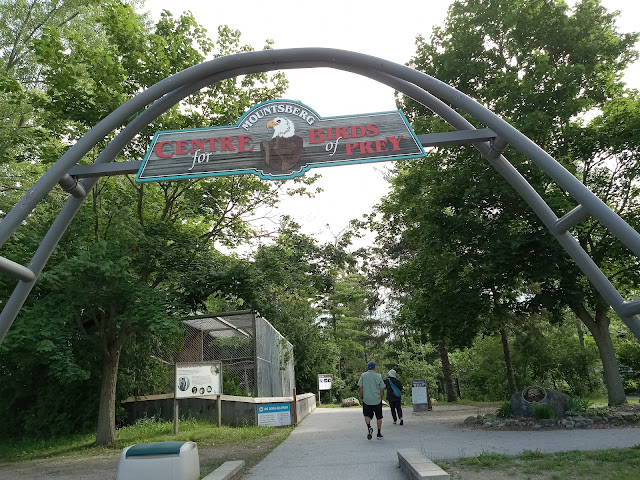Mountsberg Raptor Centre: A Quicky
It's quite common knowledge that birds are dinosaurs. While a lot of people are mistaken and think they are seperate or merely descend from dinosaurs, those are typically the older and more conservative generations, and younger generations who grew up reading about the palaeontological findings concerning the evolution of them accepy this scientific fact easily. It's also well known that raptor can refer to both dromaeosaurs and the carnivorous groups of birds, due to the claws that no doubt grip their prey for the beaks to get in more easily, the word coming from the Latin word for thief or to seieze, Rapare. Both groups from the same clade, dromaeosaurs and birds of prey inspire awe and terror throughout our minds' imaginations and artistic creations.
I write all this because earlier this month on the Eighth I went somewhere that's quite relavent to the above paragraph, and boy was it gud.
Earlier this month, I went to Mountsberg Conservation Area with my parents for a day trip, located just 30 minutes from my home in the GTA and by the Niagara Escarpment. I came for one thing only: raptors, the avian kind, all located at a Raptor Centre, right by the main parking lot.
 |
| Typical example of an aviary at MRC |
The centre was very nice to say the least. The aviaries for the birds (many of whom couldn't fly due to trauma) served each well, having perches and everything they needed, even they are a bit blan to look at. Quite a few bald eagles were making their rythimatic calls that sounded across the centre, making for an impressive place . The signage meanwhile was quite nice, covering every topic a visitor could need to know about these raptors, as well as provide info on each indivudual bird and why they are here, mostly humans hurting them and unable to return to the wild.
Highlights of my visit included:
The centre's Turkey Vultures, actually one of my favourite birds. There were two in seperate avaries, sunning themselves. I admit I can see how people don't like them, due to the admittedly gross-looking shade of red their heads are, but it's always a treat seeing them up close.
Another was a Golden eagle, at the back end of the centre.
While at first it was in the back, it came closer on another walk by, and I was amazed by how big it was up close. Like it could have a wingspan as big as my height (i'm over 5'6). It befittingly it had the largest aviary out of all the birds, taking up space normally reserved for three aviaries.
Another thing I loved was seeing new species at Mountsberg. There was the Rough-Legged Hawk, a lot of them but I had honestly never even heard of until then (at least I think so), at least five or six by my count, each in seperate aviaries. There was also the Tawny Owl (pictured above), a european owl species not represented in North American collections well. There was also the arctic Gyrefalcon, seen below.
Then came my visit's highpoint with a bird of prey demonstration my family organised last minute. It was nice, and the host was good and friendly. First she simply brought out wing specimens and feathers, before bringing out a live Kestral, then a Barn Owl, then finally a Harris Hawk. We actually saw the last one when we first arrived, the keeper bringing it in for care before the show, in a lovely start to the visit.
Mountsberg Raptor Centre was a nice place for something just 7,025 square metres, appealing to both casual visitors and birders, and does a great job tending to the rescues, and rest of Mountsberg seems nice too (just beware the mosquitos - there were a lot on one of the nature trails). I give it a recommendation if you ever visit in the Hamilton area.As for links to palaeo-media however tenuous, there is this single sign by the hawks' aviaries, outling the facts I mention at the start, and making use of that. It's a useful sign that helps grab many visitors' attention and provides context, especially since most visitors already think of the non-avian theropod more then the bird clades these days.
I wouldn't say ALL dinosaurs were feathered, though. Plausible, maybe, but its unlikely that the sauropodimorphs, especially the more derived sauropods lacked them entirely, and skin impressions do suggesat many big ornithopods lacked them entirety. Also, I don't really like the use of stock art here, even it was probably done for time probably like 15 years ago and admittedly hasn't aged TOO bad. If I were in charge, I'd probably commision a palaeoartist to get original art for the sign. Still, it's good to see this signage here, combining two things I love.
- Exhibit Design - 8/10
- Interpretives - 8/10
- Overall - 9/10
Bye for now.













Comments
Post a Comment